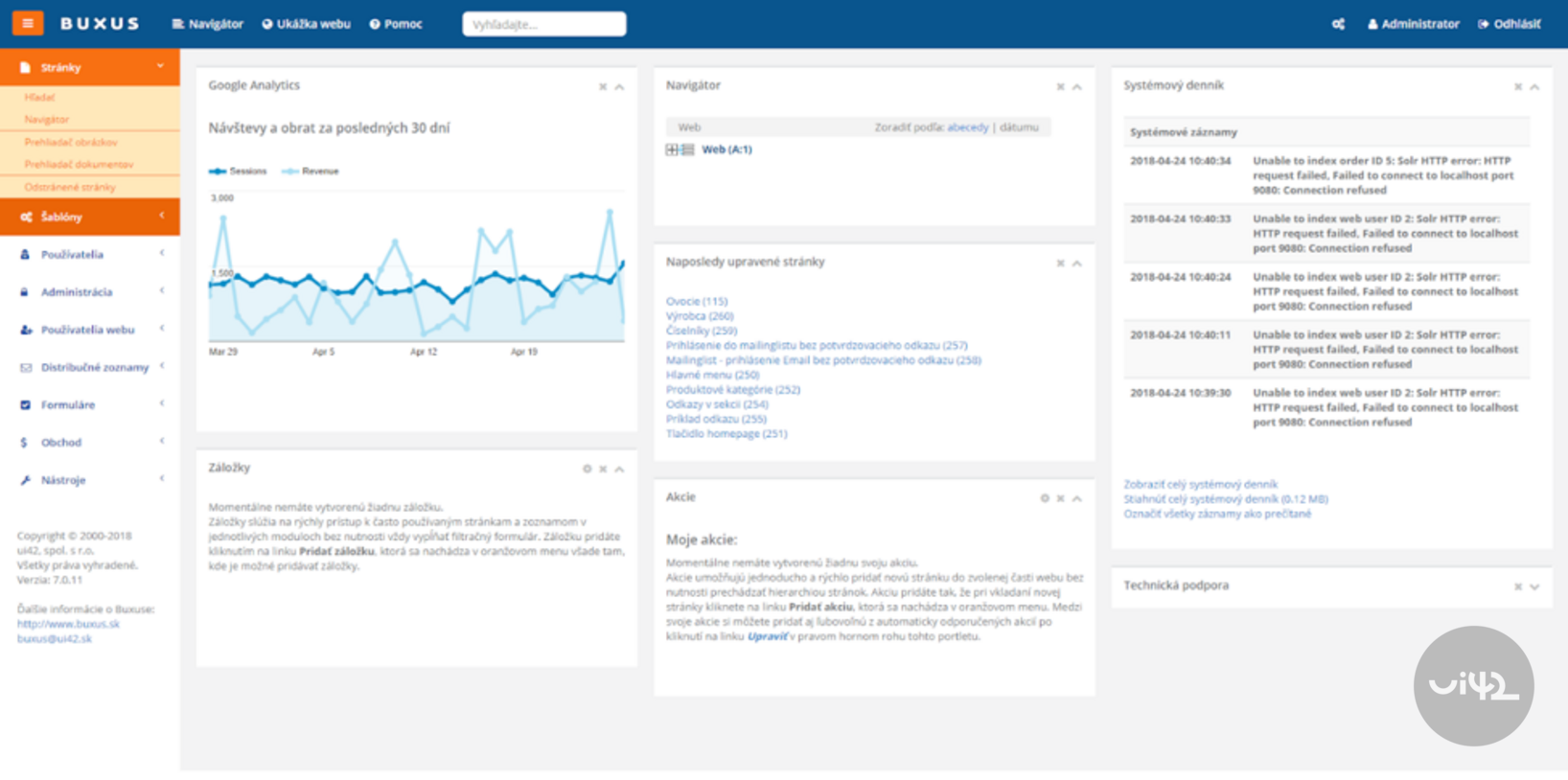Nicely in order. What is a CMS?
CMS (Content Management System) is software for publishing and editing website content. In Slovak, the commonly used term is editorial system.
Currently, the most famous and widespread CMS in the world is WordPress, which was launched in 2001. The first online editorial systems appeared a year earlier, but since then the main requirements for their functionality have not changed. They must support decentralized content management, efficient publishing without knowledge of HTML/CSS, management of multiple CMS users and their authentication, uniform graphic design, separation of content and graphic design, the publishing process, and the ability to preview.
In the world, CMS have been a fundamental element of e-commerce solutions since the beginning of their existence. Here, due to the slower onset of online sales, editorial systems provided support for e-shops only occasionally. The change occurred around 2005 when editorial systems began to allow e-shop functionality and thus the first specialized editorial e-shops focused only on e-shops began to appear. Currently, we call them e-commerce CMS or e-shop system.
What does e-commerce CMS provide?
Compared to regular CMS, e-commerce CMS must provide a much wider range of functionality for the average e-shop visitor, as well as for the e-shop manager and their marketing team. We bring you a list of functionalities that a good e-commerce CMS should be able to ensure. We divided the checklist according to the needs of e-shop customers and the team of its operators. However, it should be taken into account that the list is not complete, as e-commerce is evolving and new requirements for the functioning of e-shops are emerging.
Functionality, design, frontend, and UX of the e-shop
- Management of the e-shop
- Order management
- Online marketing of the e-shop
- Support for customers and repeat purchases.
Functions, design, frontend, and UX of the e-shop
- Custom graphic design or according to a template, which, however, can also be used by other e-shops
- Responsive version for smartphones and other mobile devices
- Megamenu and fat footer
- Optimized shopping cart and purchasing process
- Payment gateways and installment purchases (e.g., CardPay, TatraPay, Paypal, Quatro, Wplatba, Homecredit, GP webpay, ČSOB, Besteron, B-Payment, 24pay, TrustPay, GoPay, SporoPay)
- Delivery services and pickup points (UPS, Zásielkovňa, DPD, GEIS, DEPO, Slovak Parcel Service, PickPackPont, Balík na poštu, GLS, Slovenská Pošta + Electronic Submission Form)
- Full-text search with support for Slovak
- Faceted search
- Tools for products (such as watchdog, wishlist, reviews, ratings, or comparator)
- Recommended and similar products
- Support for external tools (Exponea, Persoo)
- Speed (using caching)
- Generating AMP pages
- Security (including SSL certificates)
- Support for accessibility of the e-shop for the disabled
Management of the e-shop
- The ability to create e-shops in other countries with language versions and their own pricing including foreign currencies.
- Support for translation and localization into other languages, for example, including linking to GoogleTranslate.
- Multidomain websites
- Product catalog with any number of categories (product variants, one product in multiple categories, or the possibility of dynamic categories)
- Editing multiple pages and properties at once
- The user interface for the e-shop manager must be usable and must support efficient content and order management
- Hierarchical structure for clear management of the e-shop (even for tens of thousands of products)
- Inheritance of properties (change of property in the entire category of products)
- Search and replace tool to change texts for many products at once
- Linking the e-shop to a warehouse system, possibly to an external product catalog and an external system for managing prices and discounts
- Automatic price adjustment of products based on competition monitoring
- Linking to warehouse systems
- Margin and turnover reports
- Support for web analytics (Google Analytics including Enhanced E-commerce, Google Tag Manager, Hotjar)
- Scalability (preparation for growth from hundreds to tens of thousands of products, respectively even hundreds of thousands and preparation for multiple growth in traffic)
- Flexible import/export of pages from/to CSV/XLS/XML
- Access rights for users according to their roles for separate parts of the e-shop.
- The ability to set the user interface for users in different language versions
- Unwanted changes can be reverted back to the original state.

Image: E-commerce CMS BUXUS (link to www.buxus.sk)
Order management
- Advanced order management (notification emails to the e-shop manager, notifications to the customer via email or SMS, splitting the order)
- Quick order management via smartphone
- Automatic generation of invoices and advance invoices
- Customer and order labels (including marking those who did not pick up their orders and their inclusion in the blacklist)
- Linking to billing and accounting systems (Abra, Money, Kros, MRP, Pohoda, Profit365, Superinvoice)
- Linking to courier companies
Online marketing of the e-shop
- Integrated SEO tools for advanced SEO settings without programming
- Export and synchronization with comparators (automatic change of promo texts or intelligent bidding - Heureka, Pricemania, or Najnakup)
- XML exports for Google AdWords (support for PPC campaigns and their tools: Ad Boost, MagicScript, and Google AdWords remarketing)
- Simplified SQL (creating ad-hoc queries to the database) for the needs of marketing workers without knowledge of SQL
- Dynamic categories and faceted filter for precise targeting of PPC campaigns and SEO
- Target pages (landing pages), flexible creation of target pages
- Blog
- A/B testing
Support for customers and repeat purchases
- Newsletters targeting different customer groups
- Online chat, integration with Facebook Messenger
- Advertising banners
- Email about an unfinished purchase
- Customer zone (login via Google or Facebook, customer groups and price levels)
- Loyalty program, discounts, and vouchers (quantity discounts, discounts based on the value of the purchase or shipping price according to the delivery address, gift with product)
- B2B sales
- Linking to CRM
- Product ratings, questions about products, I found a better price
- Pre-sale
Every e-shop is a bit different. What works for Amazon may not work for yours. Clarify your needs, which you thought about when preparing the information architecture. Find out what the considered systems are good for your workflow and way of functioning.
```











